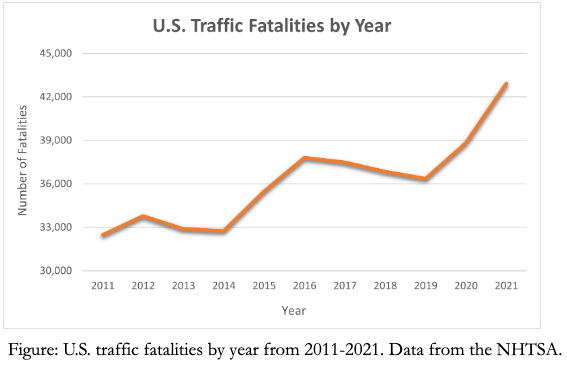In February of 2020, I shared a newsletter on traffic fatalities, detailing various types of automotive accidents and how one might reduce risk of each. Above all, I emphasized that car crashes are an extraordinarily common yet often overlooked cause of death in the United States.
Little did I know it at the time, but the problem was about to become much worse.
The Epidemic on the Road
In 2019, a total of 36,355 people died in traffic accidents in the U.S. In 2021, that number jumped to 42,915 – an 18% increase in just two years. That surge affected every age group on every type of road in every month of the year. Following a brief lull in the first 2-3 months of pandemic lockdowns, car accident fatalities have risen sharply relative to pre-pandemic levels (see Figure). And 2022 appears to be a continuation of that morbid trend, with automotive deaths from January through March outpacing those in 2021 by 7%, according to a report last month by the National Highway Traffic Safety Administration (NHTSA).
These numbers leave us with two critical questions: why are we seeing a spike in traffic fatalities, and what can we do to prevent these tragedies?
What explains the spike?
Experts remain uncertain about the precise underlying cause(s) of the sharp uptick in motor vehicle accidents and deaths over the last two years. One popular theory holds that pandemic-related stress led to increased rates of reckless driving. Data from 2020 and the earliest months of 2021 appear to support this idea, as both speeding-related and alcohol-related accidents saw dramatic spikes during this period (+17% and +14% from 2019 to 2020 for speeding and alcohol, respectively). However, by spring of 2021, both of these trends had started to reverse, with the latter months of 2021 demonstrating a decline in these categories relative to 2020. Yet overall fatalities continue to climb.
Another possible explanation is that motor vehicle traffic has changed due to the rise in work-from-home arrangements. Fewer cars on the road means less traffic, and less traffic means drivers have greater opportunity to speed or weave across lanes. And although overall traffic density has approximately returned to pre-pandemic levels, the patterns of that traffic remain altered. An analysis released earlier this year indicated that the timing of rush hour shifted in many cities across the U.S. and other countries, and several areas demonstrated increased traffic levels during off-peak times of day, likely reflecting the schedule flexibility afforded by working from home.
Still, with circumstances continuing to evolve in the aftermath of the pandemic, definitive explanations are likely to remain elusive. As the Figure above shows, the recent spike occurred on a backdrop of a more general upward trajectory since 2014 – it’s possible that the pandemic merely added to or accelerated a trend often attributed to distracted driving. Whatever the reason, the current numbers should terrify everyone. For all the emphasis we place on preventing chronic diseases, accidents – and in particular, accidents involving motor vehicles – also constitute a major cause of death, especially for those under the age of 50, and rates are rising at an alarming pace.
So how can we prevent motor vehicle accidents and fatalities?
Unlike chronic diseases such as cancer and cardiovascular disease, the “cure” for traffic fatalities will depend more on technology and policy than on medicine and health science. On the plus side, we as a society already have pretty clear evidence of effective strategies for improving the problem – e.g., stricter speed limit enforcement, restrictions on commercial and residential building along arterial roads, and mandates for safety features such as automatic emergency braking. On the minus side, we as individuals are very limited in our power to enact those strategies.
But that doesn’t mean we’re helpless to protect ourselves and others. When it comes to preventing automotive deaths, there are two steps that each of us can take:
1. Don’t be part of the problem.
Drive at safe speeds and without impairments from drowsiness, alcohol (or other substances), or distractions. Be especially cautious at night, in poor weather conditions, and in areas where pedestrians and cyclists are common, such as intersections. If possible, avoid driving in conditions which cause excessive stress, for instance by shifting schedules to miss rush hour traffic or using public transportation to avoid city driving.
2. Assume everyone else on the road is part of the problem.
As I said in my 2020 newsletter, assume that there is at least one person on the road at all times who is trying to kill you. Whether you are a driver, pedestrian, or cyclist, be vigilant in watching out for him (or them). Maybe he’ll be swerving across lanes on a bidirectional 2-lane road. Maybe he’ll come at you by running a red light. Maybe he’ll just be following too closely on the interstate, pressuring you into driving unsafely and causing an accident yourself. His tactics are many, and he can be anywhere.
Perhaps someday cars and roads will be safer by design. But until that day comes, approach every moment in or near automotive traffic with all the alertness and caution of one walking through a minefield. Increasingly, your life – and the lives of others – may depend on it.
– Peter
For a list of all previous weekly emails, click here.





